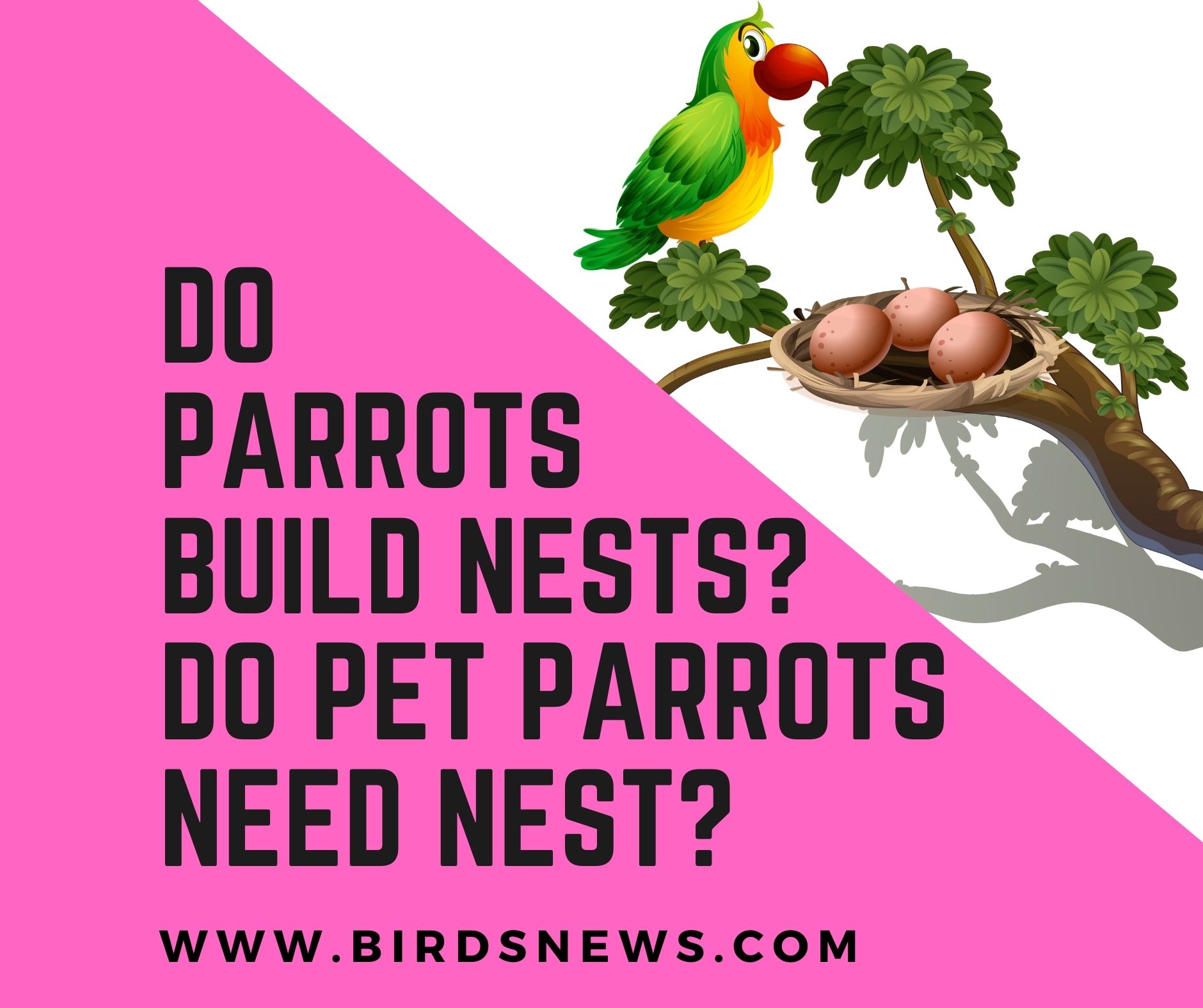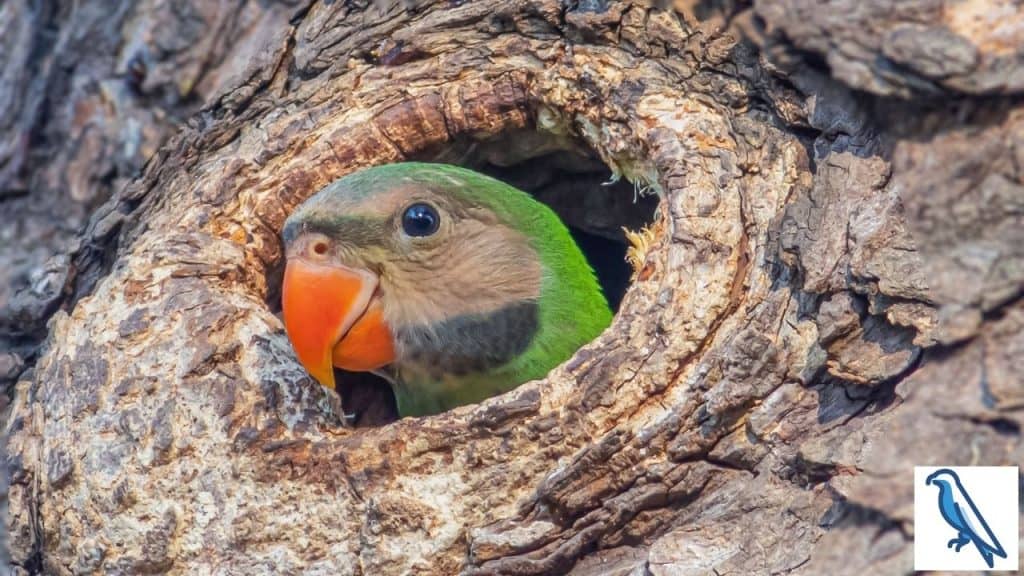
Parrots are unique and rarely follow the tendencies of other birds. Today we look at how different they are regarding nesting habits.
Not all parrot species build a nest. The Monk Parrot (Quaker) and Lovebird build nests similar to other birds.These two parrot species build nests with twigs, leaves, and grass.
But for the majority of parrots, holes in trees and cliffs provide suitable nesting environments.
Most parrots use what’s already available to them, holes in trees from fallen branches, holes in the ground. Some even use termite mounds to create their nests.
So now the question is, “Why do only some parrots build their nests while most use holes and nests that are already available to them?”
Why Do Parrots Build Nests?
The primary reason for building nests is to raise their young. Nests are a way of keeping their young safe from predators. It’s a warm place to incubate their eggs until their young ones are born.
The newborns are safe in the nest while their mother/father goes out searching for food. The female remains in the nest during the incubation period, and the male parrot feeds her and the young.
Depending on the species, the young stay in the nest between 3 weeks to 4 months.
As previously mentioned, only a few parrot species build nests in trees with twigs and leaves. In comparison, most parrots use holes in trees and cliffs to nest in.
So, let’s also gain insights into where do parrots build their nest in the wild.

Where Do Parrots Build Nests?
Parrots build their nests in various places depending on their situation. Most commonly, they build their nests in trees, but they also build nests on the sides of cliffs, burrows, or ground.
The Burrowing Parrot is known to dig holes into cliffs, wells, queries, and pits to create homes for their young. These types of parrots are hardly ever seen nesting in trees.
Parrots build their nests in places where their young would be safest. They mostly go high in trees or cliffs to protect their young from predators and interference.
They try to conceal their nests to protect their offspring from flying, falling off, and ground predators, but they are not always safe.
Parrots build nests close to food sources, so they don’t have to leave their young alone for too long. There’s always a risk of predators preying on their offspring.
Interesting Further Reading:
- Do Parrots Cry? + Why Do Parrots Cry?
- Do Parrots Have Tongue? + Use Of Parrot’s Tongue
- Why Do Parrots Live So Long? + How To Make A Parrot Live Longer In Captivity?
- Why Do Parrots Eat Paper? + Is Paper Consumption Dangerous For Parrots?
How Do Parrots Build Nests?
Parrots find pre-existing hollows in trees from snapped branches to nest inside. They take advantage of the natural decomposition of the dead trees and branches lying in the forests.
They take over woodpecker holes. Woodpeckers move out, and parrots move in. Some parrots may make the hole wider if they feel it’s necessary.
Many Military Macaw Parrots move into tree cavities created by the Imperial Woodpecker. The Imperial Woodpecker is close to extinction, and the parrots will have to rely on other birds to carve out big holes for them.
When palm trees are healthy, they provide food for parrots. When they die, they provide nesting holes for parrots.
The tree might die because of a lightning strike, bug infestation, or severe storm. The tree’s core becomes exposed and rots away, leaving the parrot’s place to build nests.
Orange Chinned Parakeet and Blossom-Headed Parakeet can carve holes into soft trees. But most trees are too hard, and it’s rare for parrots to dig a complete nesting hole themselves.
Growing palm trees shed big branches that leave a big part of the base behind on the trunk. These chunks on the side of the trunk remain attached for many years.
The hard trunks covered with these fibrous masses are perfectly suitable for White-winged Parakeets and Yellow-Chevroned.
The Sun Parakeet and Fischer’s lovebird make nests between old palm tree leaves.
Burrowing Parrots excavate burrows in cliffs and riverbanks near the ocean.
Maroon-fronted Parrot digs their nests on high vertical cliffs to protect their nests from predators.
Thick-billed parrots rely on old pine tree cavities. But because we harvest these trees for timber, these parrot numbers are decreasing drastically.
Following parrots use holes in cliffs as nests:
Brown-throated, Red masked, Red-fronted Conures, Hyacinth, Lear’s, Green-winged, and Military Macaws.
Some of them don’t excavate their cavities. Instead, they rely on natural crevices.
Some African Lovebirds build their nests out of grass and sticks in tree cavities.
The Quakers uses trees, towers, or telephone poles to build their nests. They construct their nest mostly from sticks. Their nests can contain up to 20 chambers and can be six feet long, and weigh 400lbs.
10% of parrots are known to make their nests in termite mounds. Some known species are the Orange-fronted Conure, Grey-cheeked Parakeets, Green-rumped Parrotlet and Hooded Parrot.
The Hooded Parrot uses earthly termite mounds. On the other hand, most species use termite mounds that are found in trees. Parrots use these termite mounds even where termites are still present. The termites seal their section off, leaving these two to live in harmony.
Alright! Now that you are aware of how different species of parrots build the nest. So, the next thing you may wonder is whether parrots prefer sleeping in nests?
Do Parrots Sleep in Nests?
Wild parrots sleep in nests, their version of a nest is in the form of holes in the trees and ground.
These nests are dark and safe for them to be protected against the weather and predators. It’s warm enough to incubate their eggs and safe enough to keep them from being eaten.
Although, sometimes their nests get ruined before they’re done with it because they use trees that are already on the brink of collapse.
Okay! So, till now, we have mainly discussed how wild parrots build their nests. But what about the pet parrots? In captivity, they mostly stay in the cage. So, do pet parrots need a nesting box?
Why Do Pet Parrots Need a Nesting Box?
Pet parrots need a nesting box to simulate what they enjoy in the wild. Holes in trees and cliffs. They feel safe in these types of enclosures, not just for incubating eggs but also for sleeping.
Most pet parrots will be happy with you covering their cage with a thick blanket. It will create much-needed darkness for them, and they won’t be scared of anything moving around at night.
A small nesting box inside of the cage can give them a dark environment to feel safe inside. You can use an inspection door to inspect the nest or use the peephole to see if a mother parrot has laid eggs and if everything is okay.
Pet parrots sometimes chew the wood from their nesting box for wood chips to raise the surface for their young and keep them clean. Different species of pet parrots need different nest boxes. Parrot owners use L shape nesting boxes for breeding parrots.
Recommended Further Reading:
- Can Parrots Live Alone? (What Are The Consequences?)
- Can Parrots Be Domesticated? (Why Are Parrots Domesticated)
Points To Remember
Only a tiny percentage of parrots gather sticks, leaves, and grass to build nests. Most of them use already excavated nests and make it their homes for their young to feel safe and warm.
Parrots use cliffs, cavities, termite mounds, hollows, or holes to make their nests. They need nests to lay and incubate their eggs till their young are born, and it’s a safe place for their young to stay while the parents are out looking for food.
They build nests close to food supplies and high away enough for predators not to reach. Parrots also camouflage the nest to safeguard themselves from predators further.
Pet parrots enjoy nesting boxes for their young to be safe and warm. Even if they aren’t raising chicks, they enjoy the privacy and sense of security inside a smaller wooden box.
Some parrot species are going extinct because of a lack of safe space to nest and breed.
10% of parrot species make their nests in termite mounds. They live side by side after termites seal their part off.

Hi, There and Welcome to BirdsNews.com, is here to help you learn and care about pet birds. and this blog is a journal of everything I’ve learned.
